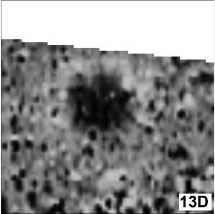
13D TO V
51 12 06.19 N 1 47 21.77 W

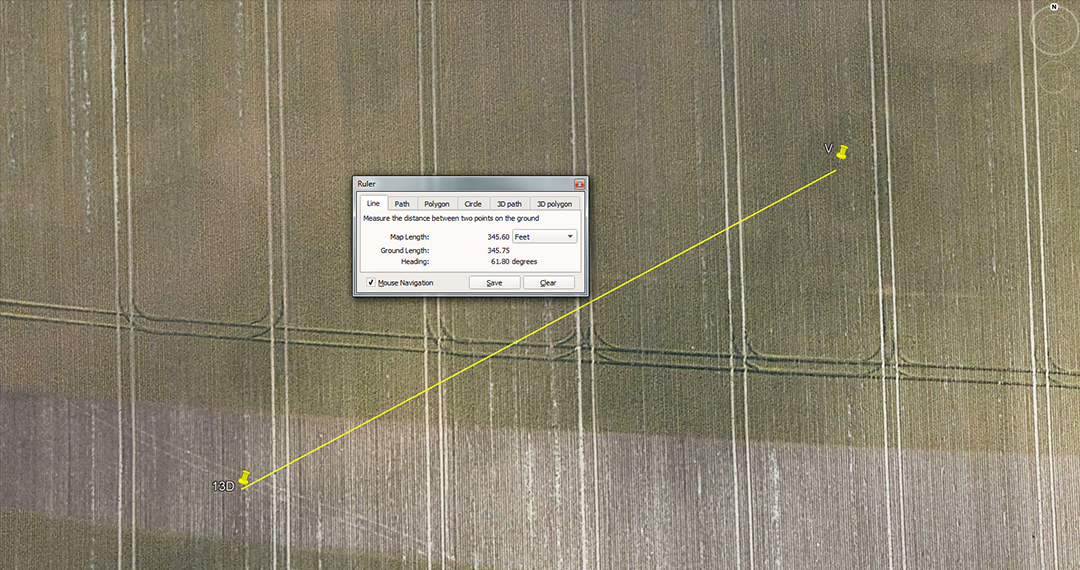
The distance is 345.6-feet and the angle is 61.8034-degrees. The distance can also be read as 350 or 352-feet respectively.
A mathematical progression based upon 345.6 goes:
345.6, 691.2, 1036.8, 1382.4, 1728, 2037.6 ... 3110.4 ... 3456 ... 4147.2 ... 5184 ... 8640 ... 9331.2 ... 12096 ... 12441.6 ... 24883.2.
To recap: 345.6-feet is the design circumference of the outer rim of the Sarsen Circle at Stonehenge; 69.12 Greek miles of 5250-feet was 1-degree of equatorial arc circumference; 1036.8 mph was the speed at which the 24883.2-mile Earth rotates; 1382.4-miles is 1/18th of the equatorial circumference, 1728 cubic inches is a cubic foot and 1728-feet is the circumference of Silbury hill under 1 coded reading based upon a 550-feet diameter; 20.376-inches is the largest of 3 close proximity Royal cubits; 3110.4-miles is 1/8th of the equatorial circumference; 51.84-degrees is the slope angle of the Great Pyramid, etc.; 864000-miles is the diameter of the sun; 933120 is the grain weight of an ancient Babylonian/Sumerian Talent; 12441.6-miles is half the equatorial circumference or the Earth and 24883.2-miles is the full circumference.
The degree angle code is one of the most important to the ancient cousin civilisations and was integral to fabricating perfect standard volume vessels for the marketplace.
The ancient method for "squaring the circle" was to use the PHI reciprocal of 10-inches ÷ 1.6180339 = 6.18034-inches and this measurement increment was used by all of the cousin civilisations for fabricating perfect volume vessels for grain, etc., sold the marketplaces.
For a king or provincial governor/ priest, trying to keep peace within regional society, few things were more threatening to harmony than "short measures" being meted out in the market place. This problem has required eternal vigilance, worldwide, since time immemorial. The responsibility to know what constitutes a correct measure in weight, volume or length, as well as the enforced maintenance of precise standards, was always a primary function of localised leadership.
The original bushel of England was, undoubtedly, based upon a Sumerian/ Babylonian volume called a Homer, which was 21600 cubic inches. The English Bushel was 1/10th of the Homer. In ancient England the tub created to measure out a correct Bushel volume was described as, "any round measure with a plain and even bottom, being 18.5 inches wide throughout and 8 inches deep". This surviving formula from the old English Winchester Standard had drifted very slightly from the more ancient formula and was now an infinitesimal shortfall of 1/25th of an inch.

A Bushel barrel with straight sides.
This exact description for a Bushel (given above) became the volume of the American Bushel, which is 2150.42 cubic inches ...derived from the old Winchester Standard and, thankfully, still preserved in the US.
Using the PHI based rendition at 6.18034 inches (6 & 1/6th of an inch in very close approximation) the correct way to achieve the final capacity is:
6.18034 X 3 = 18.54102 inches ÷ 2 = 9.27051 (squared) = 85.94235566 X PI = 270 square inches X 8 inches high above the base = 2160 cubic inches...with a margin of error of .033 of a cubic inch.

The Bush Barrow lozenge measures 6.18034-inches across its shortest diameter and 7.29-inches in length.
In the year 1808, Sir Richard Cott Hoare and William Cunnington conducted a significant archaeological excavation into a tumulus mound, situated only a short distance from the Stonehenge monument.
Workmen uncovered the remains of a tall, well built man lying in a fully extended position with his head pointing toward the south.
The grave also contained an assortment of valuable artefacts, including 3 fabricated from beaten gold, attesting to the individual's importance and station within his ancient society. Because of the presence of daggers and an axe, the deceased man was initially thought to have been a warrior.
The totality of the artefacts recovered, however, suggested that the individual had functioned in the capacity of a priest or architect at Stonehenge, as the items found with the skeleton gave an appearance more akin to ceremonial or calculation usage. Some preliminary assessments related to wooden items, in an advanced state of decay, were later modified to support a scientific function rather than a combative one.
Of these items Professor John North comments, 'Fragments of wood that the excavators had thought were the remains of a shield were now described as the remains of an alidade (a sighting rule) and wooden drawing board or plane table' (see Stonehenge, Neolithic Man and the Cosmos, page 508).
There were three daggers with bronze blades and wooden handles. A series of gold pins had held the wooden handles to the blades. Other items included a bronze axe, as well as a mace with a circular pebble head and bone inlaid wooden handle.
The now battered and bruised Bush Barrow lozenge originally measured 6.18034-inches across its shortest diameter and 7.29-inches in length (Measurements supplied by our archaeologists are only to the nearest millimetre and fall short of this by a visually undetectable amount).
Three widths = 18.54102-inches and when fabricating the wooden, circular base for a Bushel barrel tub this diameter, made into a circle, "squares the circle" to 270 square inches ... an amazing accomplishment mathematically.
Sides were then added which extended 8-inches above the top surface of the base. If the finished barrel, banded together securely by rope, were then filled to a level top surface with grain and screeded flat, the cubic capacity would be 2160 cubic inches...or one ancient English Bushel (1/10th of a Babylonian Homer).
It seems obvious that the Bush Barrow and Clandon Barrow lozenges of England, at their original, non-battered dimensions, were used in this very practical application...to create perfect Bushel quantity containers, or to check the integrity of containers used by merchants engaged in measuring out cubic quantities for sale to the public. Any cheating, shortfall irregularity in the diameter of marketplace containers could be checked by the marketplace inspector... the protector of the buying public, who carried the official "master standard" gold, assaying lozenge of office. The barrel bases had to comply to 3 widths of the Bush Barrow Lozenge.
WHY PHI?
The Bush Barrow lozenge's design width is assuredly 6.18034 inches (the result of dividing 10-inches by PHI @ 1.6180339). The reason for this is that any of the standard, cubic inch volume vessels of the cousin nations could be easily fabricated, in accordance with any of the commonly used volume standards found around the ancient Mediterranean and Europe. Let's consider some of these:
Although the cousin nations made their measures either the same or in easily calculable ratios to their trading neighbors, they also required precise formulas for fashioning very individual circular jar or tub vessels for their own coded volumes of preference. It would appear, very strongly, that the 6.18034 inch increment was used universally to calculate the circular bases for all "official standard" measuring tubs or vessels used by the great civilisations of the ancient Mediterranean Basin. For example:
Any precise volume standard used by the cousin nations could be fashioned with tremendous precision as a circular vessel when the base diameter was in allotments of 6.18034 inches. The vessels could be more squat than tall or vice-versa... it didn't matter, as long as the base retained the 6.18034 inch progression in it's diameter. The same formula, in lesser ratio, could be used to fabricate tumblers, jars or everything down to small cups for use by wine, beer or mead vendors within commercial premises.
The 6.18034 number could also be pressed into service if it was necessary to lay out circular land plots of precise square footage area. For example, an Egyptian Pyramid Acre of 28800 square feet would be a circle with a diameter of 31 X 6.8034 feet. An acre of 43560 square feet (1 furlong X 1 chain) would be a circle of 38.1 X 6.18034 feet.
It seems evident that the old Scottish Ell (37 inches) was, quite simply, 6 X 6.18034-inches originally (37.08204-inches). The Scottish Ell would work very fluidly in laying out circles of desired square footage area with reasonable calculation ease. This is, undoubtedly, one of the surviving measurements carried from Egypt to France and Britain by about 5000 BC. Half a Scottish ell could be used effectively to make Bushel barrels or tubs.
V TO 14D
51 12 07.83 N 1 47 16.96 W

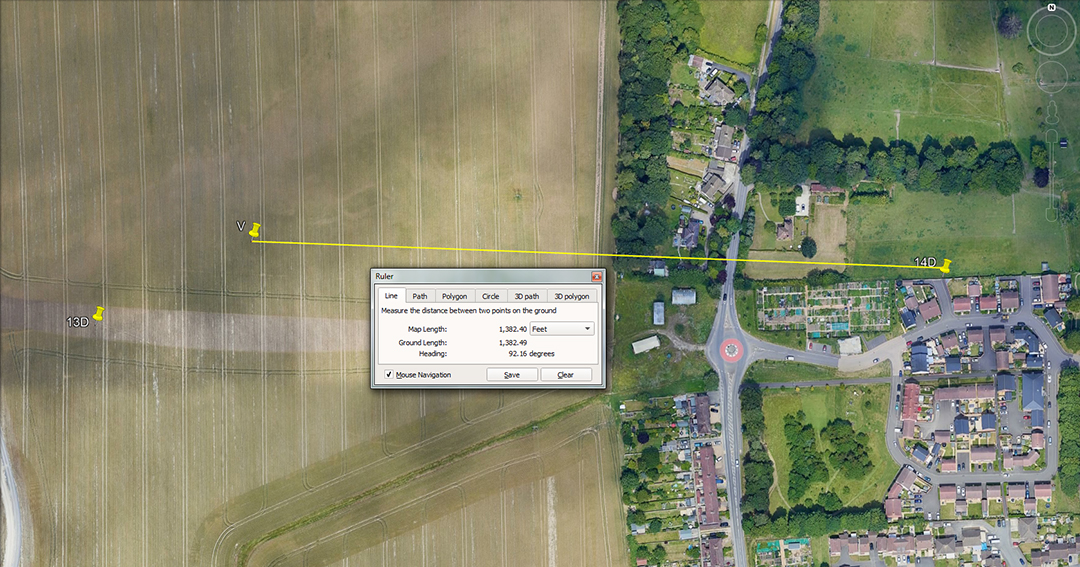
The distance is 1382.4-feet and the angle is 92.16-degrees (return angle 272.16-degrees).
A mathematical progression based upon 1382.4 goes:
1382.4, 2764.8, 4147.2, 5529.6, 6912, 8294.4, 9676.8, 11059.2, 12441.6 ... 24883.2.
The sum of 1382.4-miles is simply 1/18th of the equatorial circumference or 20-degrees of equatorial arc.
A progression based upon 92.16-degrees goes:
92.16, 184.32, 276.48, 368.64, 460.8, 552.96, 645.12, 737.28, 829.44, 921.6, 1013.76 ... 1382.4 ... 2304 ... 2488.32 ... 4608 ... 11520 ... 12441.6 ... 24883.2.
The sum of 92.16-miles would be 1/270th of the equatorial circumference or 1.33333 degrees of arc.
The value 1013.76 occurs in this string and if the Earth's equatorial circumference was considered to be 24883.2-miles of 5280-feet, then 1-second of arc would equate to 101.376-feet (58.66666 Egyptian Royal cubits of 20.736-inches).
14D TO 15D
51 12 07.13 N 1 46 55.25 W
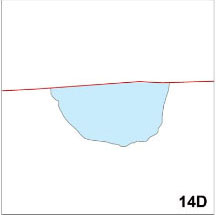
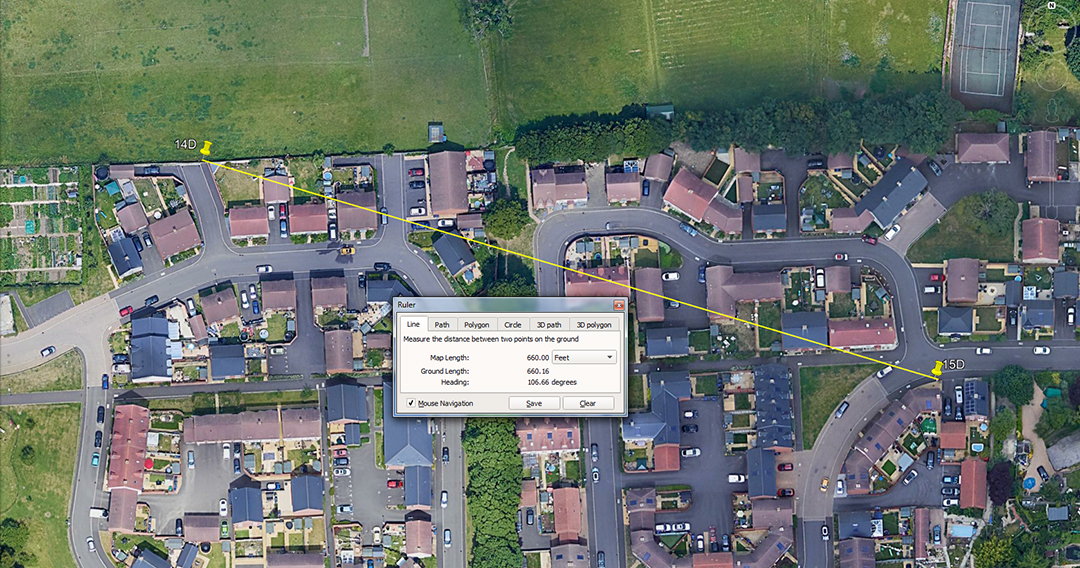
The distance is 660-feet (1-furlong) and the angle is106.6666-degrees.
A mathematical progression based upon 660 goes:
660, 1320, 1980, 2640, 3300, 3960, 4620, 5280, 5940, 6600, 4260, 7920 ... 9900 ... 10560 ... 16500.
The sum of 660-feet is 1000 links of 7.92-inches, 120 ancient merchant navy fathoms of 5.5-feet, 40 rods/perches of 16.5-feet, 10 chains of 66-feet, 1-furlong of 660 feet, 1/8th of an English mile of 5280-feet, 1/9th of a Scottish mile of 5940-feet and 1/25th of a league of 16500-feet.
The 7920 value was used to describe the diameter of the Earth in miles. If doing navigation by the 24750-mile circumference, then the form of PI used to create the circumference reading was 3.125.
If navigating by the 24883.2-mile reading, then the form of PI used to create the circumference reading was 1728/550 or 3.141818182.
The true diameter of the Earth that we use today is 7926.55-miles.
The angle of 106.66666 produces the following mathematical progression:
106.66666, 213.33333, 320 ... 640 ... 960 ... 1280 ... 1600 ... 1920 ... 2240 ... 2560 ... 2880 ... 3200 ... 3520 ... 3840 ... 4160 ... 4480 ... 4800 ... 5120 ... 5760 ... 6400.
The ancient "Pied du Roi" (foot) of France in use up until the imposition of the metric system in 1799, was 1.066666 British standard feet of 12-inches or 12.8-inches. If this foot was used to measure the length of the Great Pyramid, then 756-feet ÷ 1.0666666 = 708.75. The design length of the Khafre Pyramid (15/16ths the length of the Great Pyramid) was 708.75 standard feet. Similarly, the 11.664-inch Roman foot X 1.066666 = 12.4461-inches ... providing a foot or fraction that related to half the equatorial circumference of the Earth @ 12441.6-miles.
The sum of 106.66666-feet would equate to 100 Pied du Roi (foot of the king or royalty).
15D TO DURRINGTON WALLS CENTRE.
51 12 05.26 N 1 46 45.39 W
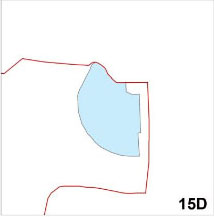
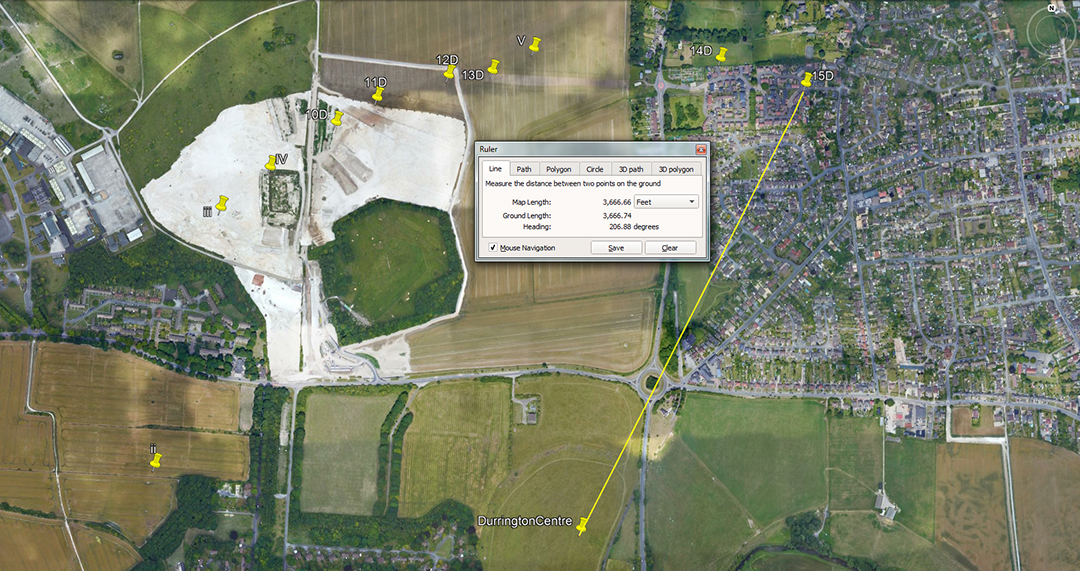
The distance is 3666.666-feet and the angle is 26.88-return. Another length would be 3652.5 (there are 365.25-days in a solar year).
A mathematical progression based upon 3666.66666 goes:
3666.66666, 7333.33333, 11000 ... 22000 ... 33000 ... 44000 ... 55000 ... 66000, etc.
The sum of 66000-feet would, of course, be 100 furlongs or 12.5-miles.
A mathematical progression based upon 26.88-degrees (in full number increments) would go:
2688, 5376, 8064, 10752, 13440, 16128, 18816 ... 26880 ... 40320 ... 67200, etc.
With the equatorial distance around the Earth set at 130636800-feet (24883.2-Greek miles), this string represents divisions. Therefore, 130636800 ÷ 2268 = 1/46800th. If measuring within 1-degree of arc (362880-feet ÷ 2688-feet = 1/135th of 1-degree, etc. Also, 1-minute of arc was 6048-feet or 2.25 X 2688.
The 360-degree compass was broken-down into 32nd, 16th, 8th, 1/4th & 1/2 divisions and the string accentuates such a breakdown. Therefore, 130636800-feet ÷ 16 = 8164800-feet or 1555.2 Greek miles of 5250-feet for 22.5-degrees of arc. Also, there would be 19440-Irish miles of 6720-feet in 130636800-feet or 1215 Irish miles in 22.5-degrees.
In an age where there weren't any electronic calculators, the mind had to be trained up to do these calculations, so number strings had to be memorised so well that they could be broken-down into useful divisions by spontaneous mental arithmetic.